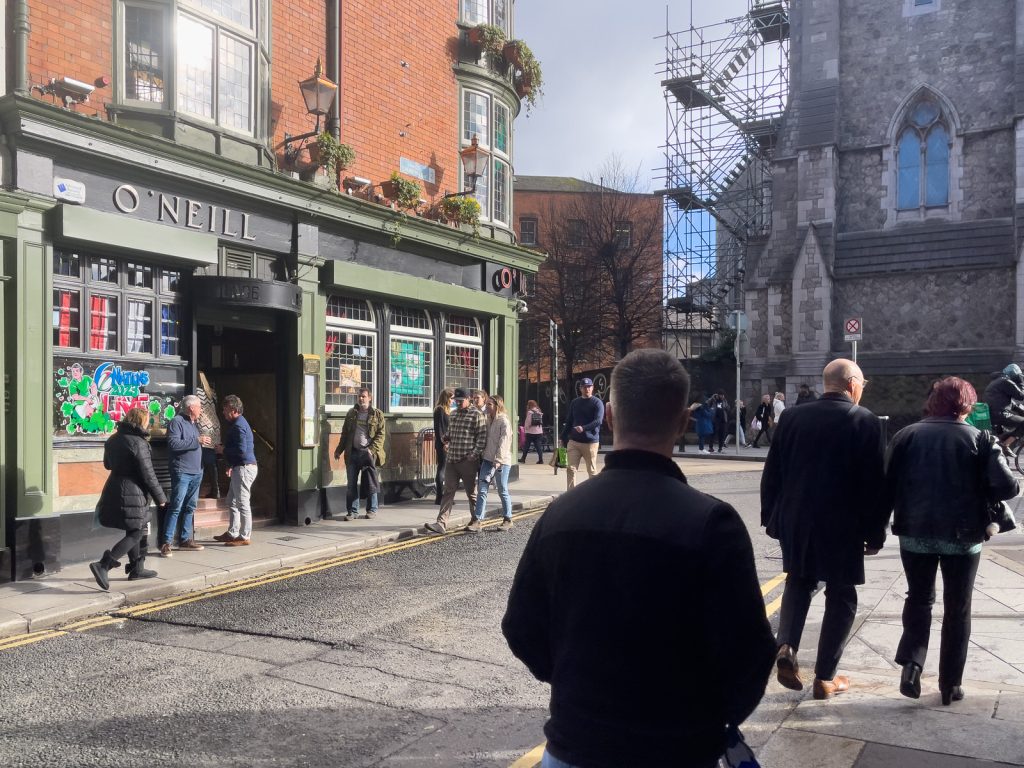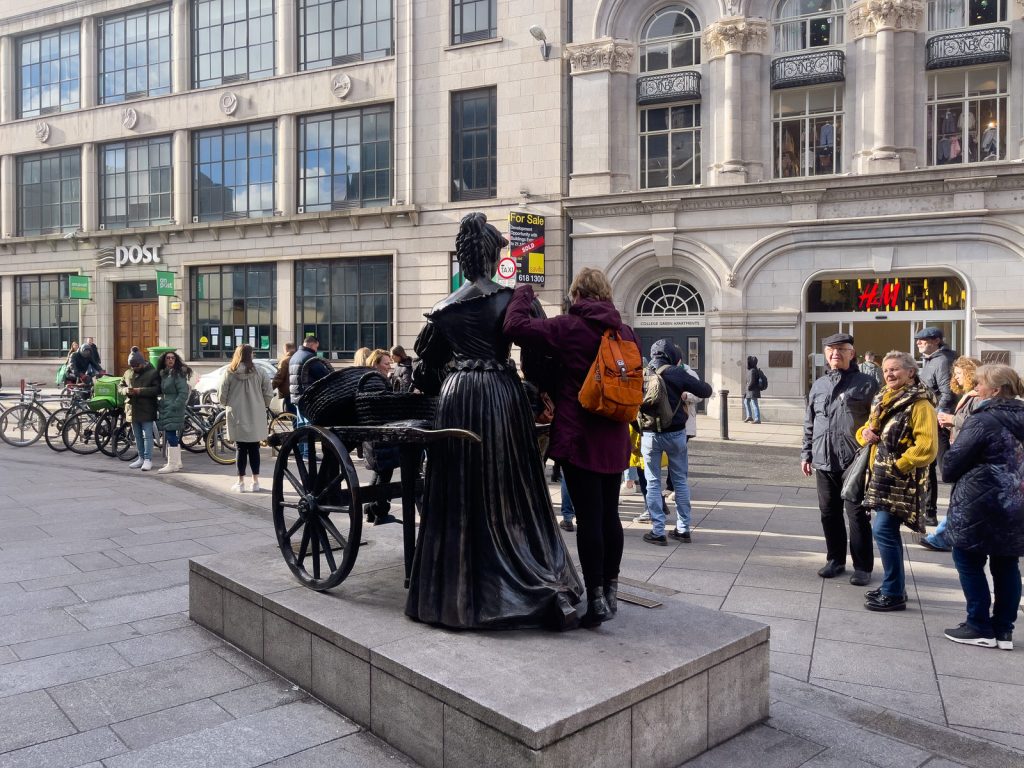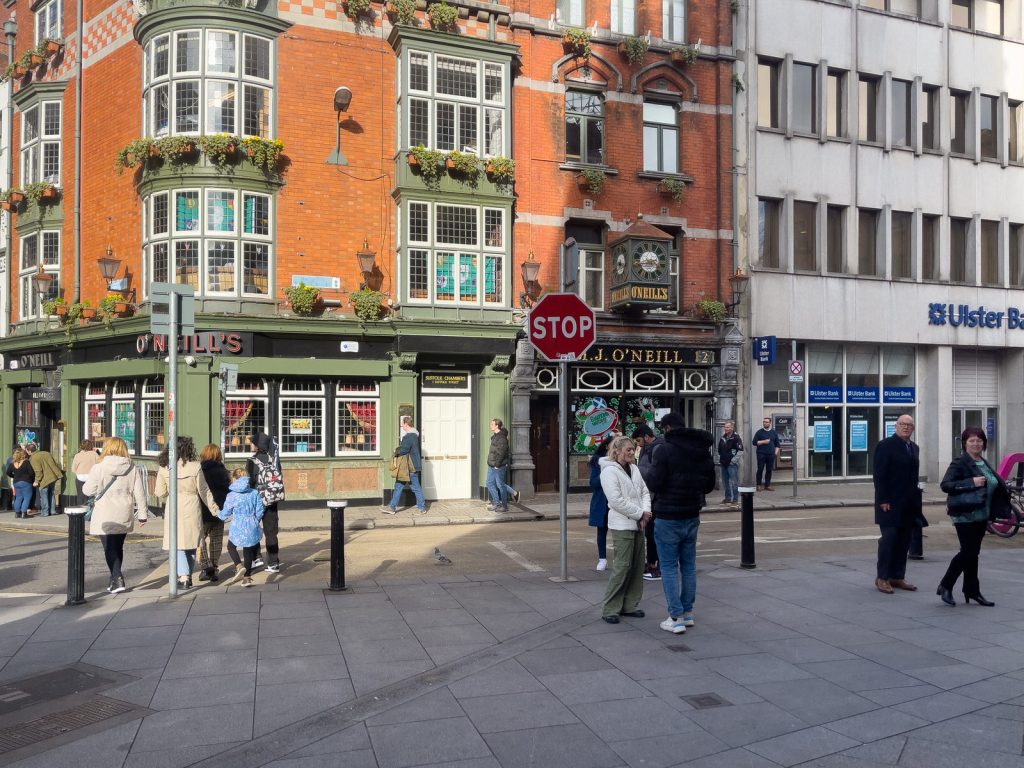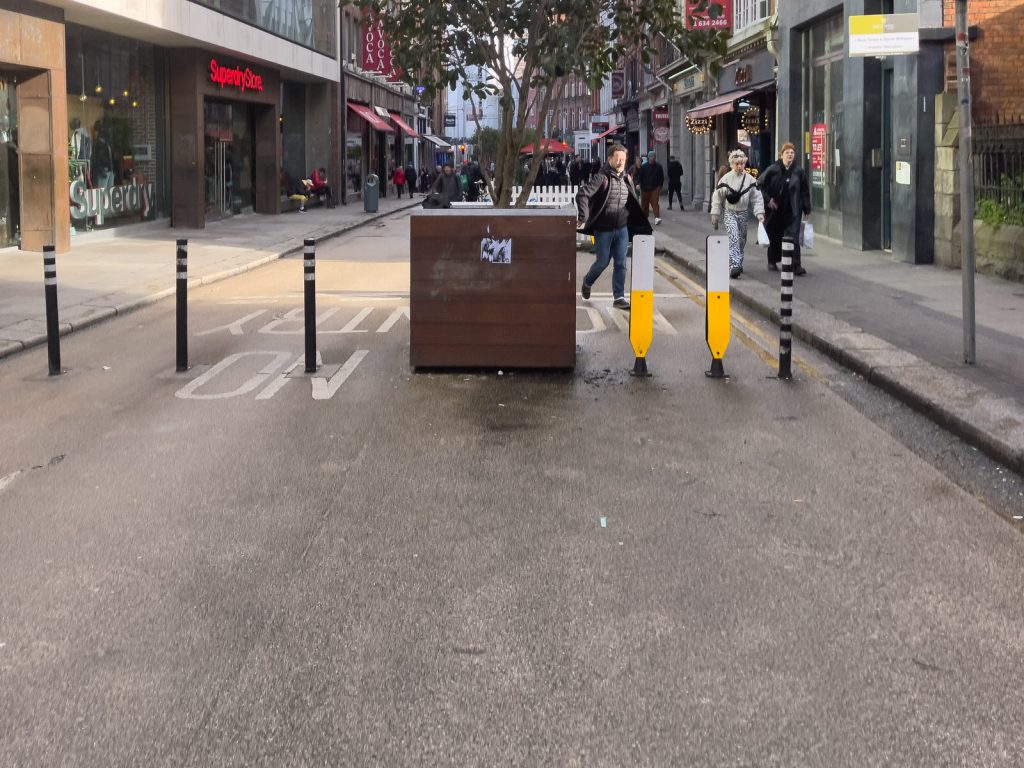ACCORDING TO GOOGLE’S BARD AI
This modern statue is located at St Kilian’s German School on Roebuck Road in Clonskeagh.
I am still experimenting with Google Bard and used it to research St Killian but some of the information was somewhat doubtful. For example I could not confirm that the Town Of Killarney [referred to as a city by Bard] is named after St Killian. The Irish for Killarney is Cill Airne meaning the “Church Of Sloes”.
Saint Killian [also spelled Cillian or Killian] was a seventh-century Irish missionary who is credited with bringing Christianity to Franconia, a region in what is now Germany. He is also the patron saint of Würzburg, the capital of Bavaria.
Killian was born in Ireland in the early seventh century. He was educated at the monastery of Clonmacnoise, one of the most important centres of learning in Ireland at the time. After his education, Killian traveled to Gaul (modern-day France) to preach the Gospel.
In Gaul, Killian met with some success in converting pagans to Christianity. However, he also made some enemies, including Duke Gosbert of Franconia. Gosbert’s wife, Geilana, was a pagan, and she was opposed to Killian’s mission.
In 689, Killian and his companions were murdered by Geilana’s followers. They were killed in Würzburg, and their bodies were buried in the city.
Killian’s death did not end his influence. He was soon venerated as a martyr, and his cult spread throughout Germany. In 742, his relics were exhumed and placed in a new church in Würzburg. The church was dedicated to Killian, and it became a major pilgrimage site.
Killian is remembered as a courageous and dedicated missionary who helped to spread Christianity in Germany. He is also celebrated as a martyr who died for his faith.
In addition to his missionary work, Killian is also known for his contributions to the development of the Church in Germany. He was instrumental in establishing the diocese of Würzburg, and he is credited with introducing the Gregorian chant to the region.
Killian’s feast day is celebrated on July 8. He is the patron saint of Würzburg, the diocese of Würzburg, and the city of Killarney in Ireland.
Killian is a significant figure in both Irish and German history. He is remembered as a courageous missionary who helped to spread Christianity in both countries. He is also celebrated as a martyr who died for his faith. Killian’s legacy continues to inspire people today.
Here are some additional facts about Saint Killian:
His name means “little champion”.
He is often depicted in art with a sword, a symbol of his martyrdom.
He was born in Ireland around the year 640.
He studied under Saint Columban at the monastery of Luxeuil in Gaul.
In 686, he set out for Franconia to preach the Gospel.
He was killed by Geilana, the wife of Duke Gozbert of Thuringia, in 689.
He was canonized in the 9th century.
His feast day is celebrated on July 8.
He is the patron saint of Würzburg, Germany, and missionaries.
St. Kilian’s German School in Dublin was founded in the early 1950s, developing from the work of a Dublin charity, the Save the German Children Society, founded in 1945. The school was originally a Sunday school, offering German classes to children who came to Ireland as part of the programme run by the Save the German Children Society.
In 1954, the school was named St. Kilian’s and three years later relocated to a site on the Stillorgan Road in Dublin, which could also accommodate a Kindergarten. The school expanded and grew in the following years, and in 1961-2011, it had a delegated Headmaster from Germany and a Deputy Principal supported by the Department of Education in Ireland.
In 1974, the school moved to its current campus in Clonskeagh. In 1976, the school was recognised by the Irish Department of Education and given a roll number. Two years later, the first group of St. Kilian’s students sat the Leaving Certificate.
In 1989, the school introduced the Sprachdiplom Exams, a significant step in establishing the higher pedagogical benchmark for the teaching and learning of German in the school. In 1992, St. Kilian’s became a member of the European Schools’ Association.
Today, St. Kilian’s German School is a thriving institution with a student body of over 500 pupils from over 30 different countries. The school offers a wide range of academic and extracurricular activities, and its graduates go on to study at leading universities around the world.
Here are some of the key milestones in the history of St. Kilian’s German School:
1952: The school is founded as a Sunday school.
1954: The school is named St. Kilian’s.
1957: The school relocates to Stillorgan Road.
1961-2011: The school has a delegated Headmaster from Germany and a Deputy Principal supported by the Department of Education in Ireland.
1974: The school moves to Clonskeagh.
1976: The school is recognised by the Irish Department of Education.
1989: The school introduces the Sprachdiplom Exams.
1992: St. Kilian’s becomes a member of the European Schools’ Association.
![SAINT KILIAN AND ST KILIAN'S GERMAN SCHOOL[ACCORDING TO GOOGLE'S BARD AI]-219901-1 SAINT KILIAN AND ST KILIAN'S GERMAN SCHOOL[ACCORDING TO GOOGLE'S BARD AI] 007](https://excellentstreetimages.com/2023HeadlessPhotoBlogWordPress/wp-content/uploads/2023/07/SAINT-KILIAN-AND-ST-KILIANS-GERMAN-SCHOOLACCORDING-TO-GOOGLES-BARD-AI-219901-1-1548x1032.jpg)
![SAINT KILIAN AND ST KILIAN'S GERMAN SCHOOL[ACCORDING TO GOOGLE'S BARD AI]-219902-1 SAINT KILIAN AND ST KILIAN'S GERMAN SCHOOL[ACCORDING TO GOOGLE'S BARD AI] 006](https://excellentstreetimages.com/2023HeadlessPhotoBlogWordPress/wp-content/uploads/2023/07/SAINT-KILIAN-AND-ST-KILIANS-GERMAN-SCHOOLACCORDING-TO-GOOGLES-BARD-AI-219902-1-1600x1066.jpg)
![SAINT KILIAN AND ST KILIAN'S GERMAN SCHOOL[ACCORDING TO GOOGLE'S BARD AI]-219903-1 SAINT KILIAN AND ST KILIAN'S GERMAN SCHOOL[ACCORDING TO GOOGLE'S BARD AI] 005](https://excellentstreetimages.com/2023HeadlessPhotoBlogWordPress/wp-content/uploads/2023/07/SAINT-KILIAN-AND-ST-KILIANS-GERMAN-SCHOOLACCORDING-TO-GOOGLES-BARD-AI-219903-1-1600x1066.jpg)
![SAINT KILIAN AND ST KILIAN'S GERMAN SCHOOL[ACCORDING TO GOOGLE'S BARD AI]-219905-1 SAINT KILIAN AND ST KILIAN'S GERMAN SCHOOL[ACCORDING TO GOOGLE'S BARD AI] 004](https://excellentstreetimages.com/2023HeadlessPhotoBlogWordPress/wp-content/uploads/2023/07/SAINT-KILIAN-AND-ST-KILIANS-GERMAN-SCHOOLACCORDING-TO-GOOGLES-BARD-AI-219905-1-1600x1066.jpg)
![SAINT KILIAN AND ST KILIAN'S GERMAN SCHOOL[ACCORDING TO GOOGLE'S BARD AI]-219906-1 SAINT KILIAN AND ST KILIAN'S GERMAN SCHOOL[ACCORDING TO GOOGLE'S BARD AI] 003](https://excellentstreetimages.com/2023HeadlessPhotoBlogWordPress/wp-content/uploads/2023/07/SAINT-KILIAN-AND-ST-KILIANS-GERMAN-SCHOOLACCORDING-TO-GOOGLES-BARD-AI-219906-1-1600x1066.jpg)
![SAINT KILIAN AND ST KILIAN'S GERMAN SCHOOL[ACCORDING TO GOOGLE'S BARD AI]-219907-1 SAINT KILIAN AND ST KILIAN'S GERMAN SCHOOL[ACCORDING TO GOOGLE'S BARD AI] 002](https://excellentstreetimages.com/2023HeadlessPhotoBlogWordPress/wp-content/uploads/2023/07/SAINT-KILIAN-AND-ST-KILIANS-GERMAN-SCHOOLACCORDING-TO-GOOGLES-BARD-AI-219907-1-1600x1066.jpg)
![SAINT KILIAN AND ST KILIAN'S GERMAN SCHOOL[ACCORDING TO GOOGLE'S BARD AI]-219904-1 SAINT KILIAN AND ST KILIAN'S GERMAN SCHOOL[ACCORDING TO GOOGLE'S BARD AI] 001](https://excellentstreetimages.com/2023HeadlessPhotoBlogWordPress/wp-content/uploads/2023/07/SAINT-KILIAN-AND-ST-KILIANS-GERMAN-SCHOOLACCORDING-TO-GOOGLES-BARD-AI-219904-1-1600x1066.jpg)
![THE CABBAGE PATCH [NEW STREET GARDENS AND CATHEDRAL LANE]-217074-1 THE CABBAGE PATCH [NEW STREET GARDENS AND CATHEDRAL LANE] 018](https://excellentstreetimages.com/2023HeadlessPhotoBlogWordPress/wp-content/uploads/2023/05/THE-CABBAGE-PATCH-NEW-STREET-GARDENS-AND-CATHEDRAL-LANE-217074-1-1421x1066.jpg)
![THE CABBAGE PATCH [NEW STREET GARDENS AND CATHEDRAL LANE]-217075-1 THE CABBAGE PATCH [NEW STREET GARDENS AND CATHEDRAL LANE] 017](https://excellentstreetimages.com/2023HeadlessPhotoBlogWordPress/wp-content/uploads/2023/05/THE-CABBAGE-PATCH-NEW-STREET-GARDENS-AND-CATHEDRAL-LANE-217075-1-1421x1066.jpg)
![THE CABBAGE PATCH [NEW STREET GARDENS AND CATHEDRAL LANE]-217076-1 THE CABBAGE PATCH [NEW STREET GARDENS AND CATHEDRAL LANE] 016](https://excellentstreetimages.com/2023HeadlessPhotoBlogWordPress/wp-content/uploads/2023/05/THE-CABBAGE-PATCH-NEW-STREET-GARDENS-AND-CATHEDRAL-LANE-217076-1-1425x1069.jpg)
![THE CABBAGE PATCH [NEW STREET GARDENS AND CATHEDRAL LANE]-217077-1 THE CABBAGE PATCH [NEW STREET GARDENS AND CATHEDRAL LANE] 015](https://excellentstreetimages.com/2023HeadlessPhotoBlogWordPress/wp-content/uploads/2023/05/THE-CABBAGE-PATCH-NEW-STREET-GARDENS-AND-CATHEDRAL-LANE-217077-1-1425x1069.jpg)
![THE CABBAGE PATCH [NEW STREET GARDENS AND CATHEDRAL LANE]-217070-1 THE CABBAGE PATCH [NEW STREET GARDENS AND CATHEDRAL LANE] 014](https://excellentstreetimages.com/2023HeadlessPhotoBlogWordPress/wp-content/uploads/2023/05/THE-CABBAGE-PATCH-NEW-STREET-GARDENS-AND-CATHEDRAL-LANE-217070-1-1421x1066.jpg)
![THE CABBAGE PATCH [NEW STREET GARDENS AND CATHEDRAL LANE]-217071-1 THE CABBAGE PATCH [NEW STREET GARDENS AND CATHEDRAL LANE] 013](https://excellentstreetimages.com/2023HeadlessPhotoBlogWordPress/wp-content/uploads/2023/05/THE-CABBAGE-PATCH-NEW-STREET-GARDENS-AND-CATHEDRAL-LANE-217071-1-1421x1066.jpg)
![THE CABBAGE PATCH [NEW STREET GARDENS AND CATHEDRAL LANE]-217072-1 THE CABBAGE PATCH [NEW STREET GARDENS AND CATHEDRAL LANE] 012](https://excellentstreetimages.com/2023HeadlessPhotoBlogWordPress/wp-content/uploads/2023/05/THE-CABBAGE-PATCH-NEW-STREET-GARDENS-AND-CATHEDRAL-LANE-217072-1-1428x1071.jpg)
![THE CABBAGE PATCH [NEW STREET GARDENS AND CATHEDRAL LANE]-217073-1 THE CABBAGE PATCH [NEW STREET GARDENS AND CATHEDRAL LANE] 011](https://excellentstreetimages.com/2023HeadlessPhotoBlogWordPress/wp-content/uploads/2023/05/THE-CABBAGE-PATCH-NEW-STREET-GARDENS-AND-CATHEDRAL-LANE-217073-1-1428x1071.jpg)
![THE CABBAGE PATCH [NEW STREET GARDENS AND CATHEDRAL LANE]-217066-1 THE CABBAGE PATCH [NEW STREET GARDENS AND CATHEDRAL LANE] 010](https://excellentstreetimages.com/2023HeadlessPhotoBlogWordPress/wp-content/uploads/2023/05/THE-CABBAGE-PATCH-NEW-STREET-GARDENS-AND-CATHEDRAL-LANE-217066-1-1421x1066.jpg)
![THE CABBAGE PATCH [NEW STREET GARDENS AND CATHEDRAL LANE]-217067-1 THE CABBAGE PATCH [NEW STREET GARDENS AND CATHEDRAL LANE] 009](https://excellentstreetimages.com/2023HeadlessPhotoBlogWordPress/wp-content/uploads/2023/05/THE-CABBAGE-PATCH-NEW-STREET-GARDENS-AND-CATHEDRAL-LANE-217067-1-1421x1066.jpg)
![THE CABBAGE PATCH [NEW STREET GARDENS AND CATHEDRAL LANE]-217068-1 THE CABBAGE PATCH [NEW STREET GARDENS AND CATHEDRAL LANE] 008](https://excellentstreetimages.com/2023HeadlessPhotoBlogWordPress/wp-content/uploads/2023/05/THE-CABBAGE-PATCH-NEW-STREET-GARDENS-AND-CATHEDRAL-LANE-217068-1-1421x1066.jpg)
![THE CABBAGE PATCH [NEW STREET GARDENS AND CATHEDRAL LANE]-217069-1 THE CABBAGE PATCH [NEW STREET GARDENS AND CATHEDRAL LANE] 007](https://excellentstreetimages.com/2023HeadlessPhotoBlogWordPress/wp-content/uploads/2023/05/THE-CABBAGE-PATCH-NEW-STREET-GARDENS-AND-CATHEDRAL-LANE-217069-1-1426x1070.jpg)
![THE CABBAGE PATCH [NEW STREET GARDENS AND CATHEDRAL LANE]-217065-1 THE CABBAGE PATCH [NEW STREET GARDENS AND CATHEDRAL LANE] 006](https://excellentstreetimages.com/2023HeadlessPhotoBlogWordPress/wp-content/uploads/2023/05/THE-CABBAGE-PATCH-NEW-STREET-GARDENS-AND-CATHEDRAL-LANE-217065-1-1421x1066.jpg)
![THE CABBAGE PATCH [NEW STREET GARDENS AND CATHEDRAL LANE]-217060-1 THE CABBAGE PATCH [NEW STREET GARDENS AND CATHEDRAL LANE] 005](https://excellentstreetimages.com/2023HeadlessPhotoBlogWordPress/wp-content/uploads/2023/05/THE-CABBAGE-PATCH-NEW-STREET-GARDENS-AND-CATHEDRAL-LANE-217060-1-1422x1067.jpg)
![THE CABBAGE PATCH [NEW STREET GARDENS AND CATHEDRAL LANE]-217061-1 THE CABBAGE PATCH [NEW STREET GARDENS AND CATHEDRAL LANE] 004](https://excellentstreetimages.com/2023HeadlessPhotoBlogWordPress/wp-content/uploads/2023/05/THE-CABBAGE-PATCH-NEW-STREET-GARDENS-AND-CATHEDRAL-LANE-217061-1-1421x1066.jpg)
![THE CABBAGE PATCH [NEW STREET GARDENS AND CATHEDRAL LANE]-217063-1 THE CABBAGE PATCH [NEW STREET GARDENS AND CATHEDRAL LANE] 003](https://excellentstreetimages.com/2023HeadlessPhotoBlogWordPress/wp-content/uploads/2023/05/THE-CABBAGE-PATCH-NEW-STREET-GARDENS-AND-CATHEDRAL-LANE-217063-1-1421x1066.jpg)
![THE CABBAGE PATCH [NEW STREET GARDENS AND CATHEDRAL LANE]-217064-1 THE CABBAGE PATCH [NEW STREET GARDENS AND CATHEDRAL LANE] 002](https://excellentstreetimages.com/2023HeadlessPhotoBlogWordPress/wp-content/uploads/2023/05/THE-CABBAGE-PATCH-NEW-STREET-GARDENS-AND-CATHEDRAL-LANE-217064-1-1421x1066.jpg)
![THE CABBAGE PATCH [NEW STREET GARDENS AND CATHEDRAL LANE]-217062-1 THE CABBAGE PATCH [NEW STREET GARDENS AND CATHEDRAL LANE] 001](https://excellentstreetimages.com/2023HeadlessPhotoBlogWordPress/wp-content/uploads/2023/05/THE-CABBAGE-PATCH-NEW-STREET-GARDENS-AND-CATHEDRAL-LANE-217062-1-1421x1066.jpg)






